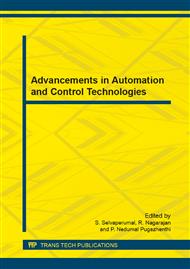p.235
p.242
p.248
p.254
p.260
p.267
p.273
p.279
p.285
Performance Comparison of pH Neutralization Process among Different Tunings of Conventional Controllers
Abstract:
The primary objective of this research paper is to develop a dynamic nonlinear pH neutralization process model, based on physical and chemical principles that can represent the specific pH neutralization pilot plant. The accuracy of this model should be sufficient to allow development of conventional and advanced control systems through simulation for subsequent implementation and testing on the plant itself. The pH neutralization process is modeled based on the reaction between strong basic solution (NaoH) and strong acidic solution (H2SO4) in Continuous Stirred Tank Reactor (CSTR). From open loop response pH system is considered as First Oder plus Dead time process. Comparison was made between four strategies like ZN, Fruehauf et al, Original IMC and Min ISTSE tuning Methods of PI and PID controllers. From the simulation results Error Indices and Time domain specifications where calculated for different tunings methods of PI and PID controller.
Info:
Periodical:
Pages:
260-266
Citation:
Online since:
June 2014
Authors:
Keywords:
Price:
Сopyright:
© 2014 Trans Tech Publications Ltd. All Rights Reserved
Share:
Citation:


